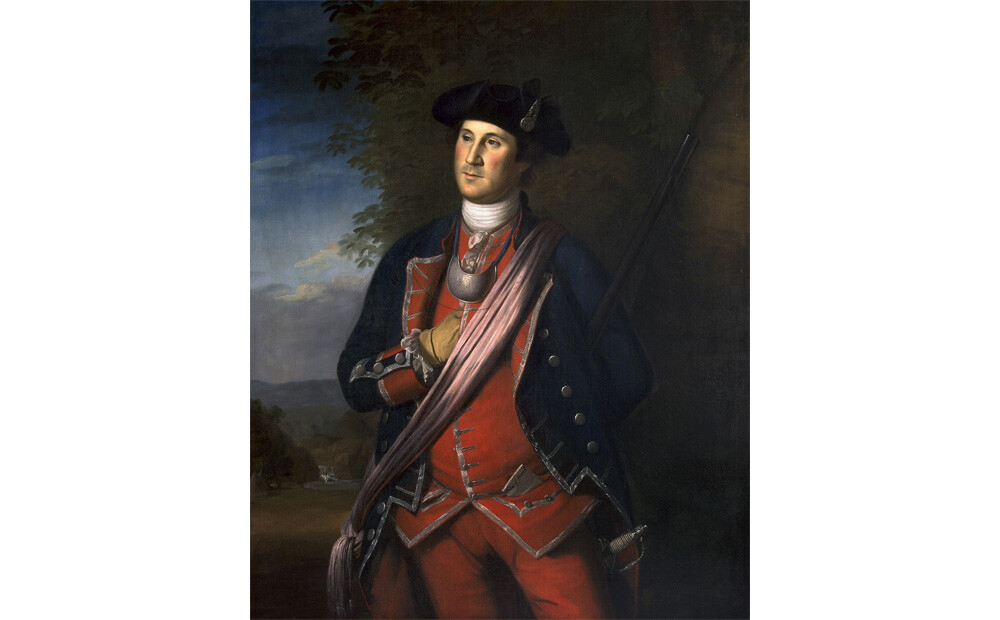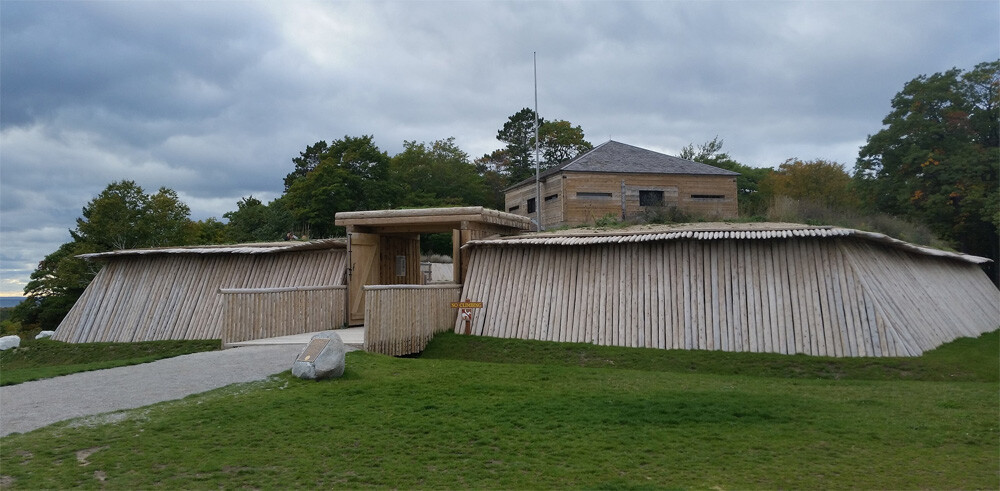The Cannibalism Incident On The Road To The American Revolution

The word “technically” can make anything sound much cooler than it really is. For example, milk is technically blood, bras are technically booby-traps, and pizza, which is just bread, tomatoes, and cheese, is technically a salad. So when we say that Wisconsin “technically” fought against the US, we don’t mean that literally since Wisconsin became a state 170 years ago while the revolutionary war took place 2021 years ago (that’s how years work, right?) What actually happened is that the people who lived on land that later became Wisconsin fought against American colonists, which may not sound that interesting but, trust us, it was totally insane. For example …
“The Father Of Wisconsin” Was Like A Native American Chosen One
In the 18th century, there was one thing in America that drove people to the highest acts of love and compassion, and the lowest forms of brutality. This thing made brother kill brother and inspired Samuel Champlain, the first European to contact the native Ottawa tribe to say: "Our young men will marry your daughters, and we shall be one people." We’re talking, of course, about beavers (pause for laughter), which isn’t a euphemism for anything (pause for disbelief.)

The fur trade in North America in the 1700s was a massive operation because this was the era before thermal underwear but after balls. Europeans were hard for that soft, warm American beaver, and they were willing to do anything to get better deals with the Native American tribes supplying the furs, and we do very much mean “anything” in the porny sense. That’s how Charles Michel Mouet de Langlade (1729 – 1801) came into the world.
His father, Augustin Langlade, married Domitilde, the sister of the Ottawa war chief Nissowaquet and a widow with six children, in order to secure lucrative fur trading deals for himself. Domitilde eventually gave birth to Charles, who spoke Ottawan as his first language and identified primarily with his mom’s people.

At age 10, Charlie’s uncle Nissowaquet (nicknamed “La Fourche” by the French, meaning … “The Fork”) had a dream where spirits told him that he should bring his nephew with him on a raid against the Chickasaws. The Ottawans apparently failed twice before, but with Charlie in tow, they scored a victory, and since then, Domitilde’s son was considered kind of a good luck charm. He would soon forge his own legend, though. Having obtained military training from Native American tribes and French colonist forces, Charles became one of the fiercest warriors in the Great Lakes area. Often described as “the bravest of the brave” or “fearless,” he led bands of braves against the British encroaching on their territory because of how much respect he’s earned among First Nations.
In 1755, he commanded a group in the Three Fires Confederacy (a united fighting force of Chippewa, Ottawa, and Potawatomi tribes) in the defense of Fort Duquesne, which later became Pittsburgh. Though he is not always given credit for it, he claimed to have organized the ambush that killed the British commander Edward Braddock. This effectively won the battle for the French/Native Americans and resulted in the colonists retreating under the command of some guy who earlier led a group of Virginians against Langlade’s forces. What was his name … ah, right, George Washington. That’s the guy.

When not kicking the ass of the guy on the $1 bill, Charles Langlade was primarily busy fur trading. Together with his father, he set up a trading post at present-day Green Bay, and was later the first person of European origin to permanently settle in the area that would eventually become the 30th state. And that’s why he is today known as “the Father of Wisconsin,” even though there really should be a “technically” in there somewhere. Still, that’s better than the other nickname he could have ended up with …
Charles Langlade Took Part In A Gruesome Cannibalistic Ritual
The past is a foreign country, but with Northern America, it might as well be another planet considering how different things used to be then. For example, people actually wanted to be in Ohio in those days. The lands that would become the state of Ohio were so rich with beavers (still funny) that France and Britain were willing to do anything to gain control of the area, and we do very much mean “anything” in the most terrifying sense possible.
Fighting for French interests in the area, Charles Langlade assembled a band of Chippewa, Ottawa, and Potawatomi warriors in 1752 and attacked the Miami tribe village of Pickawillany because they were allied with the British. 13 Miami braves were killed during the attack alongside one Englishman who, according to some accounts, had his heart ripped out and eaten by Langlade’s warriors. Now, to be clear, some Native American tribes did occasionally consume body parts of slain foes as a sign of respect and to gain their opponent’s strength. But the primary reason for Langlade’s gang going all Mola Ram on a guy was most likely intimidation. He and his braves really hated the British and they wanted to let it be known that if you’re the type of a-hole who pronounces all the letters in words, unlike the French, you better keep your ass out of Ohio. Unless you wanted said ass to be carved and served up like a Christmas ham.
To make sure that everyone got the message, Langlade and his troop sent it again, only louder and much gruesomer. During the raid on Pickawillany, Charlie also captured the Piankashaw chieftain Memeskia, nicknamed "La Demoiselle" by the French, meaning … “The Lady.” OK, seriously, never get a nickname from The French. Anyway, Memeskia was firmly on the side of the British, so he was made into an example. And by example, we mean a “meal.” The exact details are fuzzy, but some sources say that Memeskia wasn’t killed fast, which might indicate torture.

Once he was dead, his body was boiled and cannibalized by Langlade’s party in front of the rest of the Miami fighters as another intimidation technique. Miami wouldn’t suffer the same kind of disaster until 2000 when it lost 7 to 62 to the Jacksonville freaking Jaguars.
Now, no source ever gives you the definitive answer about whether Charlie himself ate a Donner Party kebab, but you have to consider the fact that the man did primarily see himself as Native American. Also it’s always weird when you’re the only person not eating at a company outing. So, yeah, there’s a very real chance that the settler of Green Bay tasted Soylent Green.
Langlade’s Actions Helped Kickstart The American Revolution
So, about the guy Langlade helped kill and eat. Yeah, yeah, we know we’re harping on it but it’s like that old saying goes: “You can win 99 battles and possibly eat 1 guy and people will not remember you as a battle-winner." Anyway, yeah, it probably won’t surprise you to hear that the British were kinda pissed that a guy fighting on the side of France killed and ate one of their allies. And this was scary Empire-era Britain, not the current “Don’t touch our fish! They’re all we have!” Britain, so first they got angry, and then they got even.
The killing of Memeskia is often cited as a direct result of Great Britain getting more aggressive with France in Northern America. This eventually led to a young George Washington ambushing and defeating French forces at the Battle of Jumonville Glen in 1754.

The battle is mostly forgotten now because it literally resulted in ONE death (on the British side) but it was all the excuse the two countries needed. Primed by Langlade’s cannibal move, France and Great Britain were officially at war. Globally, this was all a part of the Seven Years’ War, but in North America, it was called The French and Indian War (1754 – 1763) and it’s responsible for shaping the entire western world as we know it today.
One of the most important clashes of that war was the 1759 Battle of the Plains of Abraham, also known as the Battle of Quebec. As a result of it, the Brits took Canada from France, and that’s primarily why Letterkenny and Trailer Park Boys are in English instead of French. But things could have gone very differently since Langlade met one of the commanders of the British army in a skirmish before the Battle of Quebec. Some sources suggest that if he’d received the reinforcements he requested, he might have been able to stop or slow down the invasion of Canada with his Native American warriors. That’s heavily disputed, though, so let’s stick to the facts.

With the signing of the Treaty of Paris in 1763, France lost all of its American territory east of the Mississippi to Britain. But then a super weird thing happened. King George III declared that all that new land belonged to ... the Native Americans. (We can’t stress enough how much Europe wanted their beaver pelts.) The Royal Proclamation of 1763 explicitly said that no colonists can settle land west of the Appalachian Mountains unless they bought it from the Native Americans. Only they couldn’t buy it because the proclamation also gave the crown the exclusive right to purchase land from the tribes. This did not sit well with the colonists who felt that they had a pretty solid legal case of “But we WANT IT.” Tensions continued to rise, there was a party of some kind in Boston, and yadda-yadda-yadda, the United States of America were born.
Could all of this had been avoided if Langlade’s men hadn’t gotten long-pig BBQ that time? Well, let’s say yes, because it’s funnier this way.
“The Father Of Wisconsin” Fought With The British Against American Colonists
You know, for a guy who hated the British so much that he allowed the eating of their buddy (sorry for still bringing it up), Langlade switched sides pretty instantly once the French lost the war. He became a British agent and was even given the rank of captain and put in charge of Native American affairs. One time, when he heard of an Ojibwa rebellion against a local British commander, he risked his own life to warn him, then organized a dangerous rescue mission where he barely managed to save his life before the guy was to be ritually sacrificed. And while this was happening, the ghost of Memeskia probably looked at him with a pissed off look that said “OH WOW, NOW YOU’RE AGAINST THE KILLINGS OF THE BRITS AND THEIR ALLIES?”
This was kind of in character for Langlade, since fidelity wasn’t exactly his strongest suit. His first wife was an Ottawa woman named Agathe, with whom he had a son, but he left them for Charlotte Ambroisine Bourassa, the daughter of a rich fur trader to get even deeper into the beaver business.
Actually, Langlade’s decision to work for the British was mostly down to pragmatism. He had the option of escaping to France, but he’d never been to France, and Great Britain was willing to let him keep all of his holdings in exchange for his influence over various Native tribes. So he fought for them during the Revolutionary War, leading bands of braves against the rebelling colonists. But to be fair, he did also embezzle goods from the new British storehouse on Mackinac Island while doing it so…

After the war, Langlade was allowed to settle in Green Bay, which by then was part of the US, and he lived out the rest of his life in peace in a country he fought against, proving to kids everywhere that if you play both sides, you’ll come out on top. Okay, that part of his biography was totally American.